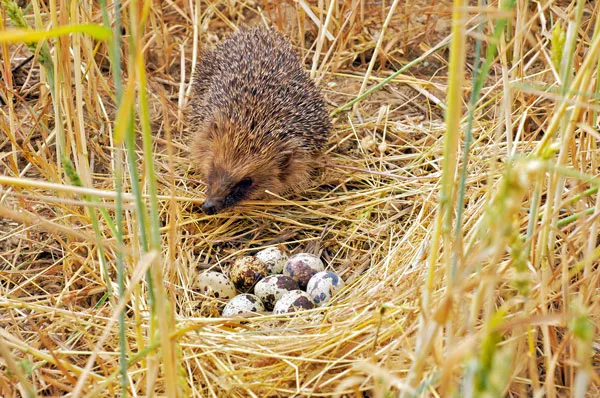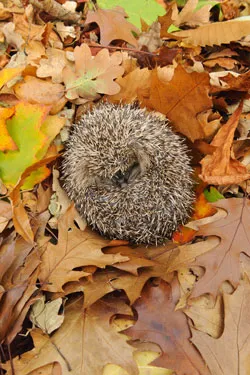Pity the weak, meek, feeble hedgehog. Most people now know that its British population is in meltdown, dropping by a third between 2003 and 2012. Poor Mrs Tiggywinkle may not be with us for much longer. Squashed by cars, poisoned by pesticides and trapped by fences, the hedgehog is becoming a victim of our modern way of life. It needs saving.
The hedgehog, and its undeniable plight, is often portrayed in the above manner. The spiny animal is seen as a hopeless waif in need of rescue. Yet how accurate is this picture, really? If we leave aside its population decline for a bit, what kind of animal are we talking about? The truth is that it is very impressive indeed.
Intrepid survivor
For example, how long have hedgehogs been around? The answer, give or take the vagaries of prehistoric measurement, is at least 15 million years. Diminutive ‘proto-hedgehogs’ as small as a human thumb have actually been unveiled from 50 million years ago, and hedgehogs the size of hares once scuttled around the Mediterranean. But the basic body plan has been around, unchanged, for longer than our minds can fathom. Hedgehogs are an ancient part of our fauna. They will have coexisted with such exciting animals as sabre-toothed cats, and, in more recent history, remains of British hedgehogs can be dated back to some 9,550 years ago. Many animals have come and gone while hedgehogs have remained abundant and successful. Even today they are found over much of Eurasia and Africa; they are not a failure.
We easily see the hedgehog as hopeless when confronted by the tyres of cars, and see it somehow as physically inadequate. Yet many animals besides hedgehogs come to grief under the wheels of cars and, for its part, our hero has some handy attributes – not least 5,000 spines that protect it from almost any predator. It can roll up into an intransigent spiny ball that has been known to bemuse and defeat a marauding lion. Its running speed can, in bursts, be as fleet as a fast human walk, and it has been known to swim across large rivers.
The hedgehog’s climbing ability is vastly underrated. It has been known to steal through first-floor windows of houses, hitching between ivy branches and drainpipes to do so, and it can surmount large obstacles such as fences and walls. This curious mammal can also, of course, survive outside in the winter as far north as Finland by drastically lowering its body temperature to go into hibernation. These are the attributes of a survivor.

Photo credit: RSPB
Yet the hedgehog inveigles sympathy out of humankind, especially in Britain, where many rescue centres and charities are devoted to its cause. In many ways, it is a curious icon, with decidedly unglamorous relatives such as moles and shrews. It isn’t particularly cuddly or beautiful. It seems to bring out affection by coming into gardens, being approachable, and having a sort of eccentric mien like a bumbling but beloved uncle. The affection afforded to hedgehogs is quite a recent phenomenon, though. As Pat Morris points out so aptly in The New Hedgehog Book, it went from being legally considered a pest in the reign of Elizabeth I to being legally protected in the reign of Elizabeth II.
Another clue to the hedgehog’s popularity is that it is an excellent bug-remover in gardens. It could be described as a generalist carnivore. While it has food preferences, with beetles, earwigs and worms among its favourite invertebrate nibbles, it can also eat a great many other items, including small mammals, carrion and sometimes, to tarnish its reputation somewhat, the eggs and young of birds. Indeed, if you wish to feed hedgehogs in the garden, dog or cat food tends to be recommended.
Decline and fall
One thing is unequivocal: the increased affection in which hedgehogs are now held is in inverse proportion to their current fortunes. Everyone agrees that the population in Britain has crashed. There may have been more than 30 million hedgehogs here during the 1950s; by 1995 numbers plunged to 1.5 million and the fall continues. Claims of imminent extinction are exaggerated, but all is not well on their horizon.

The hedgehog decline is easier to measure than to explain, and the scientists have not so far nailed a chief guilty suspect. Instead, the identity parade lines up such shady traits as habitat loss (more roads and buildings), the fragmentation and cluttering of the landscape, poor management of hedgerows, too many cars, the tidying of gardens, predation by badgers and, perhaps surprisingly, climate change – the latter leads to more floods and drowning. It’s an unpleasant and pervasive list, and that is the problem. Much of what we humans do, whether by accident or design, seems to affect these animals negatively. For example, the more roads and barriers that spring up, the harder it is for hedgehogs to roam the 2-3km they may walk each night safely, notwithstanding their climbing ability.
Despite the all-pervading gloom, the reality is that the hedgehog is not a strong candidate for extinction in Britain. The first reason is that, unless there is a danger we are as yet unaware of, an animal with such catholic tastes and no particular fussy habitat requirements should never get to the brink. It might continue to decline, but we won’t lose it completely and it will thrive in other parts of the world, too.
The second, and most important reason, is that people love hedgehogs. Not only do we look after them in rescue centres when they come to grief, but we also have the power to turn our local neighbourhoods hedgehog-friendly. This could be as simple as leaving areas of long grass to grow undisturbed in gardens and to refrain from using pesticides. Happily, hedgehogs still flourish in many suburban habitats, and it is here that we can make a difference.
The hedgehog might seem an anachronism in modern life, but history tells us it is a survivor, and will probably still be scuttling over the land that is Britain centuries hence. Its problems, however, should be a warning to us. If hedgehogs are in trouble, our general environment is sickly. Perhaps it’s the countryside that is weak and ailing, more than the prickly tough guy.
Dominic Couzens is a journalist and author specialising in natural history. He lives in Dorset and can’t help enthusing about wildlife. Books include Birds: ID Insights, the Secret Lives of Garden Wildlife and the Top 100 Birding Sites in the World.
